Sealant for the bathroom: types, selection tips and instructions for use
Repair and arrangement of the bathroom involves the mandatory closing of cracks, the treatment of joints between tiles and sanitary ware. The abundance of moisture is prerequisites for the appearance in the walls of the bathroom mold and fungus, damage to the finish.
To minimize the risks of problems, a sealant for the bathroom is used as a filler - a waterproof composition prevents moisture from entering the plumbing. The task of any owner is to competently approach his choice and learn how to apply it correctly to superficiality. This article is devoted to the solution of these questions.
The content of the article:
The main types of sealant
Sealant is a mixture of polymer, filler and hardener.
Depending on what polymer the product is based on, there are several types of sealants: silicone, acrylic, polyurethane and a combined version.
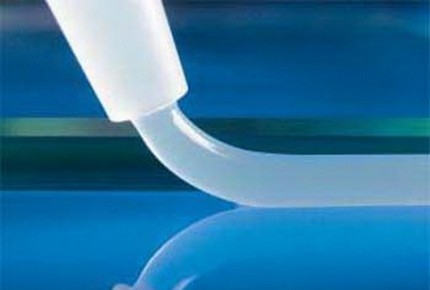
Compositions of different types have their advantages and disadvantages, especially in use.
Silicone Acid and Neutral
Silicone based sealants are among the most sought after. They combine perfectly with any type of material: ceramics and glass, wood and metal, concrete and polycarbonate.

The indisputable advantages of silicone sealants include:
- resistance to moisture;
- the ability to easily tolerate high temperature amplitudes, the range of which can vary from -50 ° to + 200 ° C;
- resistance to aggressive UV rays;
- long service life, which can reach about forty years.
The material has an elastic structure, due to which the fibers under tension can elongate by 900%. It shrinks no more than 2%.
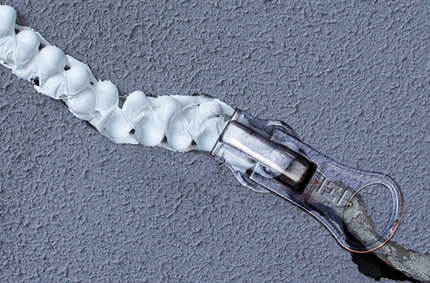
Silicone-based compounds are divided into two groups:
- One component - use for domestic purposes. They are characterized by the fact that hardening occurs at the moment of contact with air.
- Two-component - involved in the industrial field. The hardening of compositions of this type occurs upon contact with the "catalyst".
If there are no restrictions on the thickness of the putty when using two-component compositions, then hardening is achieved in household single-component sealants only if the material layer does not exceed 2-15 mm.
Household one-component compositions, depending on the type of vulcanizing substance, are presented in two types:
- acidic - acid acts as a catalyst;
- neutral - alcohol or ketoxime acts as a vulcanizer.
Acid due to the characteristic smell is also referred to as "vinegar". They are used to work with ceramics, wood and plastic. Since acid compounds are capable of oxidizing alloys and metals during vulcanization, they are chosen for treating surfaces that are resistant to rust.
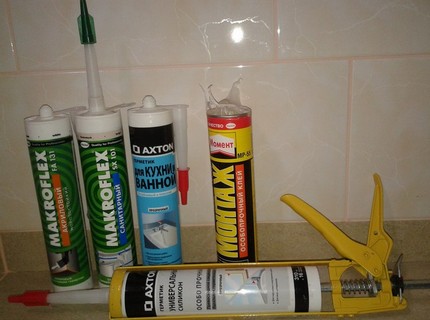
In other cases, preference is given in favor of neutral counterparts. They are ways to withstand significant temperatures and have a high level of bacterial protection.
The main thing to consider when choosing such formulations is the color, which is predominantly white or transparent. This will minimize dissonance when bath installation or installation of a shower cabin with transparent walls.
The popularity of silicone sealants and their relevance in the arrangement of bathrooms is justified by an impressive list of positive qualities, these are:
Moistureproof and Moistureproof Acrylic
Acrylic polymer-based compounds adhere well to mineral surfaces such as plaster, brick or concrete.
The main advantages of acrylic compositions:
- have a light texture;
- resistant to UV radiation;
- able to withstand temperature fluctuations from -25 ° to + 80 ° C;
The popularity of sealing compounds of this type lies in a good external effect with fairly high operational parameters against the background of affordable cost.
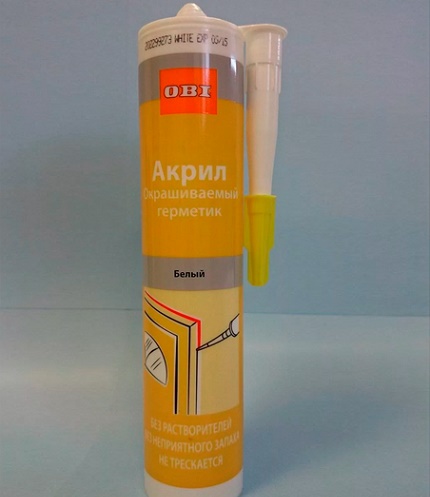
The only drawback of acrylic sealants is the low degree of elasticity. Therefore, they are best used for processing those parts of the bathroom whose surface is not subject to deformation.
In addition, with improper handling of such a composition, sloppy streaks easily form, getting rid of which is quite problematic.
Organic solvents are not present in acrylic sealants. Therefore, they are absolutely safe for human health. You can work with them even without any means of protection. Acrylic sealants harden during the day.
Silicone Acrylic Sealants
There are also on sale combined options - silicone-acrylic sealants. They successfully combine the advantages of each of the species described above separately.
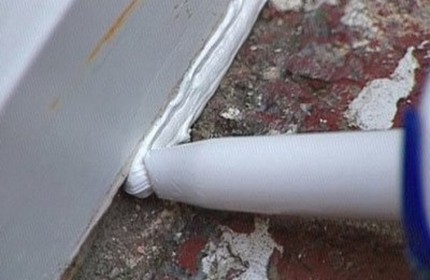
Often they are used as glue if necessary, the connection of surfaces.
Polyurethane - An Improved Chemical Product
Compounds of this type are chosen for professional construction and the implementation of major repairs. Polyurethane easily eliminates the defect in cases where previously sealed seams no longer satisfy their qualities.
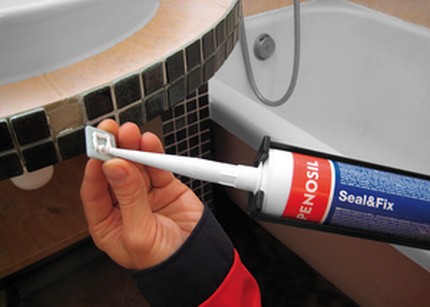
Polyurethane sealants are known for their high resistance to mechanical and chemical influences. This effect is achieved by adding rubber and various plasticizers to the raw materials. In view of the aggressiveness of some components, it is necessary to work with polyurethane compounds exclusively in protective equipment.
Separately, it is worth highlighting sanitary sealants, which contain an antiseptic agent. Due to this, in addition to the main function - a protective barrier, silicone sealants prevent the appearance and spread of colonies mold in the bathroom.
Composition and properties of sanitary sealant
For installation and repair work in the bathroom, sanitary sealant is most often used. It is a dense viscous mass.
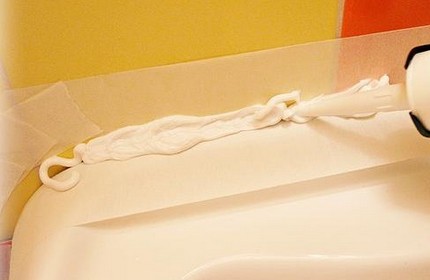
The main components of silicone sealant for the bathroom are:
- the basis, the role of which is performed by silicone rubber;
- amplifier - determines the level of strength and viscosity of the material;
- adhesion primer - determines the reliability of the coupling composition with the work surface;
- plasticizer - increases the elasticity of the material;
- vulcanizer - a substance that converts the primary form of the sealant in the form of a paste into a structure resembling plastic rubber.
In addition to the main components for improving performance, various types of fillers may be present in the sealant, for example, silica flour, glass dust or chalk, as well as extenders and dyes.
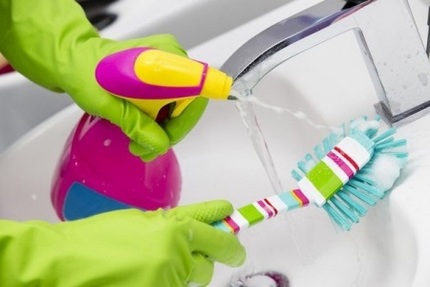
The scope of sanitary sealant is quite wide:
- joint sealing;
- bonding surfaces;
- isolation of new and updating of old seams;
- sealing the outputs of the piping of communications;
- sealing parts that will be exposed to high temperatures.
In an effort to expand the scope of application of the material, manufacturers add fungicides to the composition. These components are able to destroy mold spores and prevent the appearance of fungus, which is especially important if it is necessary to seal joints in rooms characterized by high humidity.
Competent selection criteria
Regardless of the type of polymer on which the composition is based, a high-quality sealant should have three unchanged characteristics - water resistance, safety and durability. The density of the composition should be at least 0.8 g / cm.
To strengthen the strength of the sealants are various kinds of plasticizers. But some manufacturers in order to reduce the cost of finished goods increase the percentage of additives.
To protect yourself from poor-quality material, when buying a product, it is important to pay attention to the amount of impurities. It should not exceed 10-12% of the total mass.

For work in bathrooms, it is better to choose compounds that have the marking “sanitary”. A quality product must always have warranty and accompanying documentation.
When choosing products, it is also worth considering that not all formulations can be stained after application. This is especially true if you need to install plumbing, which has a certain shade. The design of the bathroom should not suffer from inconsistent shades.
Among the budget options, it worked well:
- Sanitary Silicone famous manufacturer Tytan euro line;
- "Titanium" Polish company "Selene";
- "Moment" - a group of silicone sealants, the manufacturers of which may be specified in Russia, the Czech Republic, Belgium and Germany.
If we consider the line of professional tools, then you can safely choose for bathrooms "Sanitary" trademark Tytan Professional. From the best side proved itself and Ceresit German giant Henkel.
The only thing is that such an antimicrobial composition is not suitable for sealing aquariums and gluing food surfaces.
The following selection of photos will familiarize with sales leaders whose popularity is confirmed by successful practice of use:
Instructions for use
Surface preparation and sealant application work is best done in one day. When applying the composition in several stages with a short break, the likelihood of uneven drying is high, from which the start of operation of the bathroom may be delayed.
Preparatory work
Sealants for household purposes are available in the form of tubes with elongated spouts. Some masters, in order to create more accurate seams during application, additionally purchase special nozzles on the tubes.
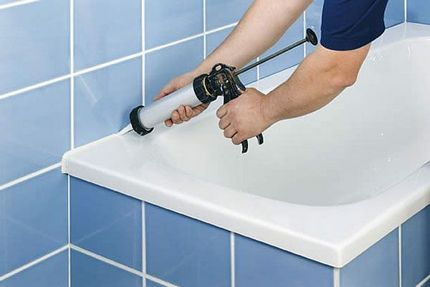
In addition to the sealant itself, it is necessary to prepare a set of materials and tools before work:
- masking tape with a width of 20-30 mm;
- white spirit, acetone or any other fat-soluble liquid;
- spatula, the width of the blade of which is selected depending on the thickness of the seam;
- cotton napkins or clean rags to eliminate flaws in the work.
When working with sealants, which contain aggressive components, it is additionally worth taking care of the purchase of personal protective equipment: a respirator, glasses and gloves.
The surface before applying the sealant must be prepared: clean from dirt, eliminate all irregularities. At this stage, you need to carefully inspect the walls for mold. If this is found, you need to fix the problem by processing the area disinfectant.
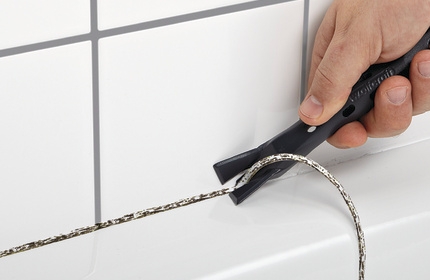
The prepared surface can only be degreased by wiping with a cloth moistened with acetone or alcohol, and dried by thoroughly wetting with a piece of cloth. Using a solvent, degrease metal parts.
To protect the treatment site from sloppy blots that can happen even with an experienced craftsman, masking tape is glued along the alleged seam.
Features of applying the composition
Before applying the composition, the tip of the nose is cut off from the tube. To increase the ease of application, the cut is done at an angle of 45 °. The bottle is installed in the mounting gun. In order to protect the mass from premature drying, the included cap is temporarily put on the nozzle.
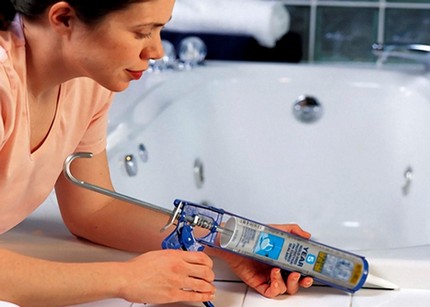
The raw materials are evenly applied throughout the seam, trying not to interrupt, so as not to create gaps in the cavity of which dirt and moisture will get into the cavity during operation.
An important point! When working with sealant, it is important to avoid direct contact of the material with the skin and mucous membrane. If the substance nevertheless accidentally enters the mucous membrane, immediately rinse the area with a copious portion of cold water.
Particular care should be taken when working with acidic composition. To protect the respiratory system from acid fumes released during the vulcanization process, work must be done by wearing glasses and a protective mask, and the room should be regularly ventilated.
Ways to eliminate minor flaws
There is nothing complicated in adjusting the finished seam. To do this, using a narrow spatula, they press the material along the applied line. Such manipulations will make it possible to better press the sealant to the surface and make the joint smoother.
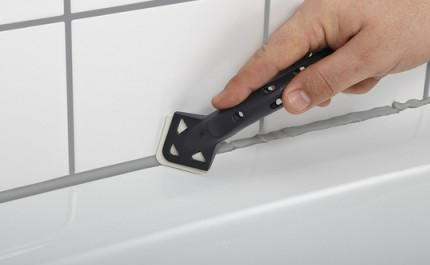
To remove sealant residues that “knock out” beyond the seam, you only need to wipe the surface with a cloth moistened with water. If this does not help, you can use white spirit, an organic solvent. "Anti-silicone" or specially designed wash "Foam-840".
After completion of work, the masking tape is peeled off. If the work was carried out without gloves, hands are thoroughly washed with soapy water.
After making sure that the applied composition is evenly and accurately distributed, it remains only to wait for it to completely dry. It will take at least a day. But it will be covered with a thin film and the composition will cease to be sticky after half an hour. If the acid version is used, then before operating the bath, it is necessary to carefully ventilate the room.
Conclusions and useful video on the topic
Some useful tips for choosing, using, and removing sealant.
Composition selection criteria:
Silicone Joint Seal Technology:
Ready-made sealant remover:
If you take full responsibility for sealing joints and seams in the bathroom, you will protect yourself in the future from many troubles in the form of manifestation of black spots of mold and fungus and make the adoption of water procedures as comfortable and safe as possible.
Looking for bathroom plumbing sealant? Or is there experience using a specific composition? Please share information with our readers - leave comments on the article, ask questions and participate in discussions. The contact form is located below.

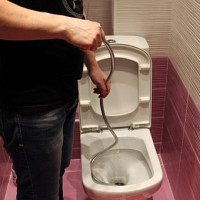 A cable for cleaning pipes: types, how to choose the right + instructions for use
A cable for cleaning pipes: types, how to choose the right + instructions for use 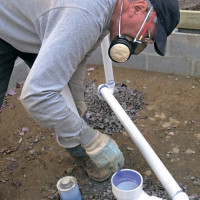 Glue for PVC pipes: an overview of the best compositions and instructions for use
Glue for PVC pipes: an overview of the best compositions and instructions for use 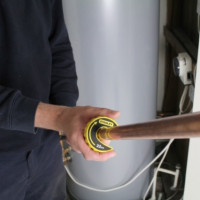 Pipe cutter for copper pipes: types, selection tips, rules and nuances of use
Pipe cutter for copper pipes: types, selection tips, rules and nuances of use 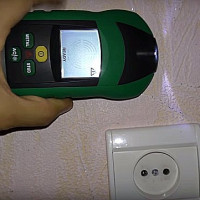 Hidden wiring indicator: principle of operation and instructions for use
Hidden wiring indicator: principle of operation and instructions for use  Scissors for cutting polypropylene pipes: species overview + instructions for use
Scissors for cutting polypropylene pipes: species overview + instructions for use 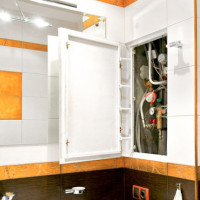 Revision plumbing hatches for the bathroom and toilet: types, placement rules, mounting features
Revision plumbing hatches for the bathroom and toilet: types, placement rules, mounting features  How much does it cost to connect gas to a private house: the price of organizing gas supply
How much does it cost to connect gas to a private house: the price of organizing gas supply  The best washing machines with dryer: model rating and customer tips
The best washing machines with dryer: model rating and customer tips  What is the color temperature of light and the nuances of choosing the temperature of the lamps to suit your needs
What is the color temperature of light and the nuances of choosing the temperature of the lamps to suit your needs  Replacement of a geyser in an apartment: replacement paperwork + basic norms and requirements
Replacement of a geyser in an apartment: replacement paperwork + basic norms and requirements
I usually use silicone sealant. I found an option that suits me (probably you should not name the brand) and always take it. In my opinion, the optimal ratio of properties and qualities of the material and its price. Just yesterday I went to change the sealant in the bathroom of one client. I thought it would be difficult to remove the old layer (it had already turned black and mold appeared), I bought a special removal tool. But it didn’t come in handy, everything was easily removed and so. Probably, high-quality sealant was used, since it did not lose elasticity over time. I always recommend that customers do not save on this consumable.
All the same, there is nothing eternal. So we took a sanitary sealant, the most popular, as the seller said. The main thing for us was that the mold did not grow at the joints.
The sealant is normal, the water in the gap does not leak, there are no complaints about this. But after a couple of months, a gray such fungus began to appear on it. And the point of what was written on the package was that it was antibacterial?
They read what it consists of - acetic acid. Still a humid environment, you need to add some special substances. Now we need to dig out and buy something new, this one has not paid off.